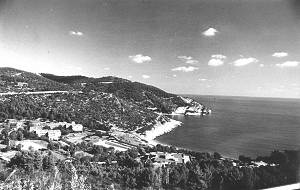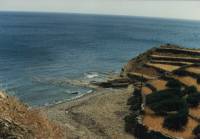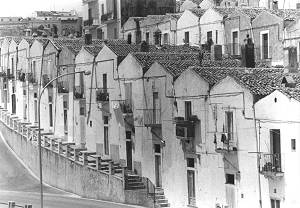page 2, page 3
by Willard Manus
Serendipity lives.
Advance word on Puglia, a province right in the heart of Italy's "Mezzogiorno,"
had not been promising. "It's the ugliest part of Italy" and
"Why Bother?" were two typical remarks addressed to us by Italian
friends when we announced our plans to pass up the fleshpots of Rome,
Florence and Venice, and head instead for the boondocks.
The first unexpected good thing happened when we checked into the Motel Agip, just north of Bari on the A-14. A five-story cement block with all the charm of a mental institution, the Agip confounded us by producing a superb five-course dinner replete with regional dishes and wines, all for less than $45 per person. An Air Italia pilot at the next table laughed at the way we over-reacted to this event.
"Unlike in the middle and north of Italy," he said, "hotel kitchens in the south are uniformly excellent. In fact, you will eat and drink as well here as you can anywhere else in Italy."

The pilot was right. Puglia turned out to be a gastronomic paradise, with good food and drink available at every turn, even in the humblest of trattorias and pizzerias. Thanks to its California-like climate and soil, this corner of Italy is overflowing with wine, cheese, fruit and vegetables of the highest quality.
Pugliese olives rate among the best in Italy, and some of its grapes are good enough to be sold to French champagne producers. There is a river of wine flowing through the province--reds, whites, roses, dessert wines, liqueurs, brandy, spumantes and digestivos, all marketed under the banner of a dozen-odd cooperatives.
Puglia's cuisine is equally sophsticated. We feasted not only on traditional Italian dishes but on such local specialties as bruscetta, a garlic bread topped with tomato, oregani and rugolo; trocelli alla foggiana, pasta and mushrooms; spigola del varano alla erbette, sea bream fried lightly in olive oil and herbs; polipo affogato, octopus stewed in red wine, tomatoes and red peppers; and calzione pulgiese, onions, tomatos, olives, capers, sardines and parsley folded and cooked in a crunchy, pitta-like crust.
With such a noble table to offer, it's hard to understand why Puglia isn't better known to travelers. True, its landscape is undistinguished, consisting mostly of lush but flat terrain, mile after mile of olive groves, vineyards and grazing grounds. Yet it does have one remarkable fairy-tale-like town, Alberobello, with its trulli, tiny, crooked, whitewashed houses with peaked roofs right out an animated film, and there are any number of gratifying sites to visit--hilltop castles, city museums, Paleochristian ruins. We were never bored during our week-long tour of the province, finding something of interest wherever we went and especially loving the region's sunlit, open, airy feel.
It is amazing just how unspoiled the Gargano is. Italians and Germans come here in sizable numbers, but only in the high season. As for Americans, a scant 75,000 visited last year, mostly on brief bus trips from either Rome or Naples.
The way to do the Gargano is by renting a car; the whole peninsula becomes your playground that way. You will not only experience the thrill of adventurious mountain driving, but picnic in private places, swim on uninhabited beaches, stay in remote inns and pensioni. We spent three days touring the Gargano in a leisurely, unplanned way; it wasn't enough.
The truth struck home the first time we encountered the seacoast town of Vieste. Built on a high, rocky finger of land with the sea swirling around it, Vieste's medieval houses and churches rise up in startling silhouette against the hard-blue sky, a magical sight. To prowl its steep, twisting streets and investigate its chapels and fortress was especially mesmerizing. We could have stayed here several nights, enjoying its physical beauty, fresh seafood, taking part in the passegiata--evening stroll--with the whole town turning out to amble around the main streets, gossiping, joking, flirting, buying roast mushrooms and chestnuts from the vendors.
But we had to move on. Too much to see: the mountain village of San Giovanni Rotondo, for example, a kind of Italian Lourdes. In 1920, a local priest, Padre Pio, had visitations followed by stigmata that recurred several times a week thereafter, until his death twenty years later. Italians still flock to his church to pay homage to Padre Pio and pray for miracles.
We also wanted to visit another unusual village, Monte San Angelo, with its underground cave-church that was once the sanctuary of St. Michael, and to take a motorboat tour of the Pugniochiuso coastline, with its dramatic rock formations, deep grottoes and jewel-like bays.
We did not manage to visit the Gargano's two beautiful lakes, or to visit its nearby island of Tremiti. A prison island during Mussolini's reign, Tremiti sits about 12 miles off the Gargano coast and has become a tourist attraction, thanks to its crystal-clear waters and walled town. Next time.
Meanwhile, we were more than content with the ground we covered, simply because enjoyable things kept happening almost everywhere we went. Take the visit to the Umbra Forest, for example.
No sooner had we reached the central "pic-nic" grounds when a family from nearby Foggia invited us to help celebrate a son's name day. We sat down to feast on trochiette, pasta in the shape of little ears, grilled sardines, salad, a semolina dish, almond cakes, grapes and pears, all washed down by copious amounts of wine and moscatos.
The topper was the
appearance of a hired folk music troupe, dancing and singing Old World
tarantellas, with everyone joining in raucously and happily.
Good times, good fortune--that about sums up our visit to Puglia.

